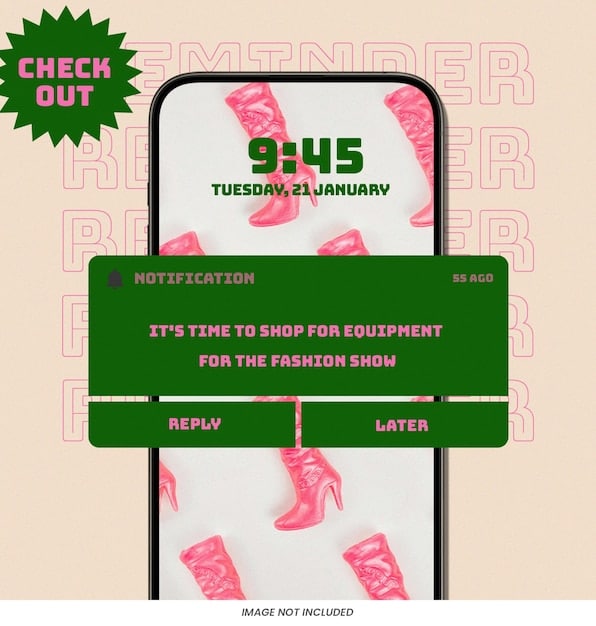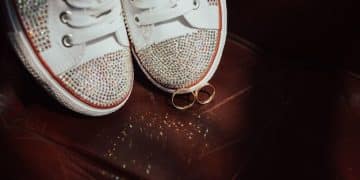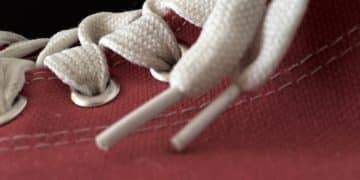Sneaker Resale Platforms Compared: Find the Lowest Fees in 2025

Comparing sneaker resale platforms in 2025, this article analyzes fees across major marketplaces like StockX, GOAT, and eBay, helping you find the most cost-effective option to maximize profit when selling your sneakers.
Navigating the world of sneaker resale platforms compared: which offers the lowest fees in 2025? can be tricky. With numerous options available, understanding the fee structures is crucial to maximizing your profits. This guide dives into the fee structures of top platforms, helping you make informed decisions.
Sneaker Resale Platforms: An Overview of the Landscape
The sneaker resale market is booming, offering both buyers and sellers opportunities to engage with limited-edition footwear. However, various platforms cater to this demand, each with its unique fee structure.
Understanding these fees is crucial to ensure you’re getting the best deal, whether you’re looking to offload a pair or expand your collection. Let’s break down the key players and what they charge.
The Key Players in Sneaker Resale
Several platforms dominate the sneaker resale scene, each with its own set of features and user base. These include StockX, GOAT, eBay, and smaller niche platforms. Each platform operates differently, impacting the fees associated with selling.
Here’s a summary of the major platforms:
- StockX: Operates as a live marketplace with bidding and asking prices, focusing on authenticity verification.
- GOAT: Offers a curated selection with strict verification processes, attracting a high-end clientele.
- eBay: A broader marketplace with a vast user base but varying levels of authentication and buyer protection.
- Smaller Platforms: Includes marketplaces such as Grailed (which, while broader than just sneakers, includes them), and others which may focus on specific brands or sneaker types.

Each platform’s model influences its fees and overall profitability for sellers. Knowing the nuances of each can guide sellers to choose the platform best suited for their needs. Factors to consider include the type of sneakers being sold, target audience, and desired profit margin.
Understanding the landscape is the first step in navigating the sneaker resale market. By familiarizing yourself with the major players and their unique offerings, you can make informed decisions that optimize your profits.
Decoding the Fee Structures: StockX
StockX is a popular platform for sneaker resale. Its commission structure can be intricate, but understanding it is key to maximizing profits.
StockX fees are based on a transaction fee combined with a processing fee. Sellers need to understand the nuances of these fees to accurately assess their potential profit.
Understanding StockX Fees
StockX employs a tiered fee structure. The fee starts at a base rate and decreases as the seller’s sales volume increases. New sellers typically start at a higher fee percentage, which gradually decreases as they reach certain sales milestones. This promotes loyalty and rewards frequent sellers.
- The starting transaction fee is usually around 9% for sellers with low sales volume.
- Processing fees are typically around 3% of the transaction value.
- Fees decrease as you reach higher seller levels based on sales volume.
Sellers also need to be aware of additional costs such as shipping. StockX charges the seller for shipping the sneakers to their authentication facility. These costs, though seemingly small, can add up, especially for sellers moving large volumes of products.
By understanding the tiered fee structure and factoring in shipping costs, sellers can more accurately predict their profit margins on StockX. This knowledge is crucial for making informed decisions about pricing and sales strategies to maximize returns. StockX continuously updates its fee structure, so it is essential to stay up-to-date by regularly checking their official website for any changes.
GOAT Fees: What You Need to Know
GOAT (Greatest Of All Time) is known for its stringent verification process. It also has a unique fee structure that sellers need to understand.
GOAT fees are composed of a commission fee, a seller fee, and a cash-out fee. Properly understanding these fees is the key to calculating potential profits.
Breaking Down GOAT’s Fee System
GOAT’s fee structure varies based on the seller’s rating and the condition of the sneakers. High-rated sellers with well-maintained sneakers generally pay lower fees, while sellers with lower ratings or sneakers in poorer condition are subject to higher fees.
- Commission fees typically range from 9.5% to 30%, based on seller rating and item condition.
- Seller fees are generally around $5.
- Cash-out fees apply when transferring earnings to your bank account.
GOAT is strict about condition and authenticity. Sellers offering fake or poorly maintained sneakers can face penalties, including higher fees or even account suspension. GOAT’s stringent standards often appeal to buyers looking for quality and assurance.

To maximize profitability on GOAT, sellers should focus on maintaining high ratings by providing accurate descriptions, quality products, and excellent customer service. Understanding the complexities of GOAT’s fee structure is essential for optimizing revenue. Keeping track of your performance metrics and understanding how they affect your fees can significantly improve your earnings.
eBay: A Different Approach to Fees
eBay offers a different landscape for sneaker resale, characterized by a simple fee structure but it comes with its unique challenges.
eBay charges an insertion fee and a final value fee. While the fees might appear straightforward, understanding all the cost components, including potential promotional fees, is necessary to be successful.
Navigating eBay’s Fee Structure
eBay’s fee structure is relatively straightforward. Sellers are charged an insertion fee for listing an item and a final value fee when the item sells.
- Insertion fees vary based on the starting price and category but are often minimal.
- Final value fees are typically around 12.9% of the total transaction, plus $0.30 per order.
- Optional promotional fees can increase visibility but add to the overall cost.
eBay’s fees are generally more predictable than those of platforms like StockX or GOAT, although they can still add up, especially for high-value items. With its vast user base, eBay offers sneakers to a wide range of potential buyers. Competition can be fierce, however, the platform can still be profitable with the right approach.
To minimize fees on eBay, sellers should consider optimizing their listings to increase visibility without relying heavily on promotional features. Sellers should also strive for excellent customer service to avoid returns or disputes.
Sellers should also pay close attention to eBay’s policies regarding sneaker sales, especially given the increased scrutiny on counterfeits. Following best practices and providing accurate descriptions can help to maintain a positive selling record and avoid additional costs.
Comparing Fees: Which Platform Wins?
Deciding which platform offers the lowest fees isn’t straightforward. It depends on a variety of factors, including sales volume, sneaker condition, and seller rating.
Comparing the fees of StockX, GOAT, and eBay is vital for making an informed decision as a seller to determine the fees you’ll encounter.
A Comparative Overview of Platform Fees
Here’s a simplified comparison of the fee structures on each platform:
- StockX: Tiered fees with a base transaction fee around 9% and a processing fee of 3%. Lower fees for high-volume sellers.
- GOAT: Commission fees ranging from 9.5% to 30%, plus a $5 seller fee and cash-out fees.
- eBay: Insertion fees (often minimal) plus a final value fee of 12.9% and $0.30 per order.
For sellers with high sales volumes, StockX can be the most cost-effective option due to its tiered fee structure. These sellers can potentially reduce their transaction fees significantly by reaching higher seller levels. However, smaller sellers or those selling sneakers infrequently might find eBay more appealing due to its straightforward fee system. Meanwhile, sellers offering high-quality, authenticated sneakers can benefit from GOAT’s premium market. A strategic approach to selecting the right platform is critical for maximizing profitability in the sneaker resale market.
Ultimately, the best platform depends on individual circumstances and preferences. Sellers should carefully consider their needs and goals before making a decision. It is important for all sellers to stay updated on any changes or promotions that these platforms may offer, as these can influence the costs associated with selling and maximize profits.
Tips to Minimize Resale Fees in 2025
Minimizing fees is essential to maximizing profits. Here are some tips to consider.
There are several strategies that sellers can employ, that go beyond simply selecting the ‘lowest fee’ provider, to reduce their outlay and increase their net revenue.
Strategies for Reducing Fees
Sellers can employ several strategies to minimize the impact of resale fees.
- Maintain High Seller Ratings: Higher ratings often correspond to lower fees on platforms like GOAT.
- Optimize Listings: Well-optimized listings can increase visibility on eBay without relying on promotional fees.
- Increase Sales Volume: StockX’s tiered fee structure rewards sellers with higher sales volumes.
Another strategy is to take advantage of promotions and discounts offered by the platforms. Many platforms offer periodic incentives to encourage sellers. Sellers can also explore alternative platforms that might offer lower fees for specific types of sneakers or sales volumes.
Sellers can also consider selling directly to buyers through social media, dedicated online forums, or local sneaker communities. While this approach requires more effort in terms of marketing and customer service, it can eliminate platform fees entirely. Furthermore, it allows sellers to build direct relationships with buyers, fostering trust and repeat business, this is useful for building a long-term business in sneaker resales. Diversifying the platforms on which sneakers are sold is a good way to manage risk and maximize overall profits.
By implementing these strategies, sellers can effectively reduce the fees associated with sneaker resale and increase their overall profitability. Keeping these tactics in mind can empower sellers to navigate the dynamic world of sneaker resale in 2025 effectively.
| Key Point | Brief Description |
|---|---|
| 💰 StockX Fees | Tiered fees decrease with higher sales volume, plus processing fees. |
| 📈 GOAT Fees | Commission varies by seller rating and sneaker condition, plus seller fee. |
| 🛍️ eBay Fees | Straightforward fees: insertion fee (if applicable) plus final value fee. |
| 💡 Minimize Fees | Maintain high ratings, optimize listings, and explore alternative platforms. |
FAQ: Sneaker Resale Platform Fees
StockX typically charges a transaction fee starting around 9%, which decreases as your sales volume increases. Additionally, there’s a processing fee, generally around 3% of the sale price.
GOAT’s fees include a commission fee (9.5% to 30% based on seller rating), a seller fee (around $5), and cash-out fees. Higher-rated sellers generally pay lower fees. Always check the latest fee structure on their website.
eBay charges an insertion fee if you list more than the free amount, and a final value fee, which is typically 12.9% of the total transaction amount, plus $0.30 per order.
To minimize fees, maintain high seller ratings, optimize your listings to increase visibility, take advantage of any promotions, and increase your sales volume when possible to qualify for lower rates.
The platform with the lowest fees varies depending on your sales volume and seller rating. StockX can be cost-effective for high-volume sellers, eBay for smaller sellers, and GOAT for those with high-quality sneakers.
Conclusion
Choosing the right sneaker resale platform involves weighing various factors, including fees, ease of use, and target audience. Understanding each platform’s fee structure and strategies to minimize costs is essential for maximizing profits in 2025. Carefully assess your own needs and priorities, and stay informed about changes within the resale market to make the best decision for your reselling business.





